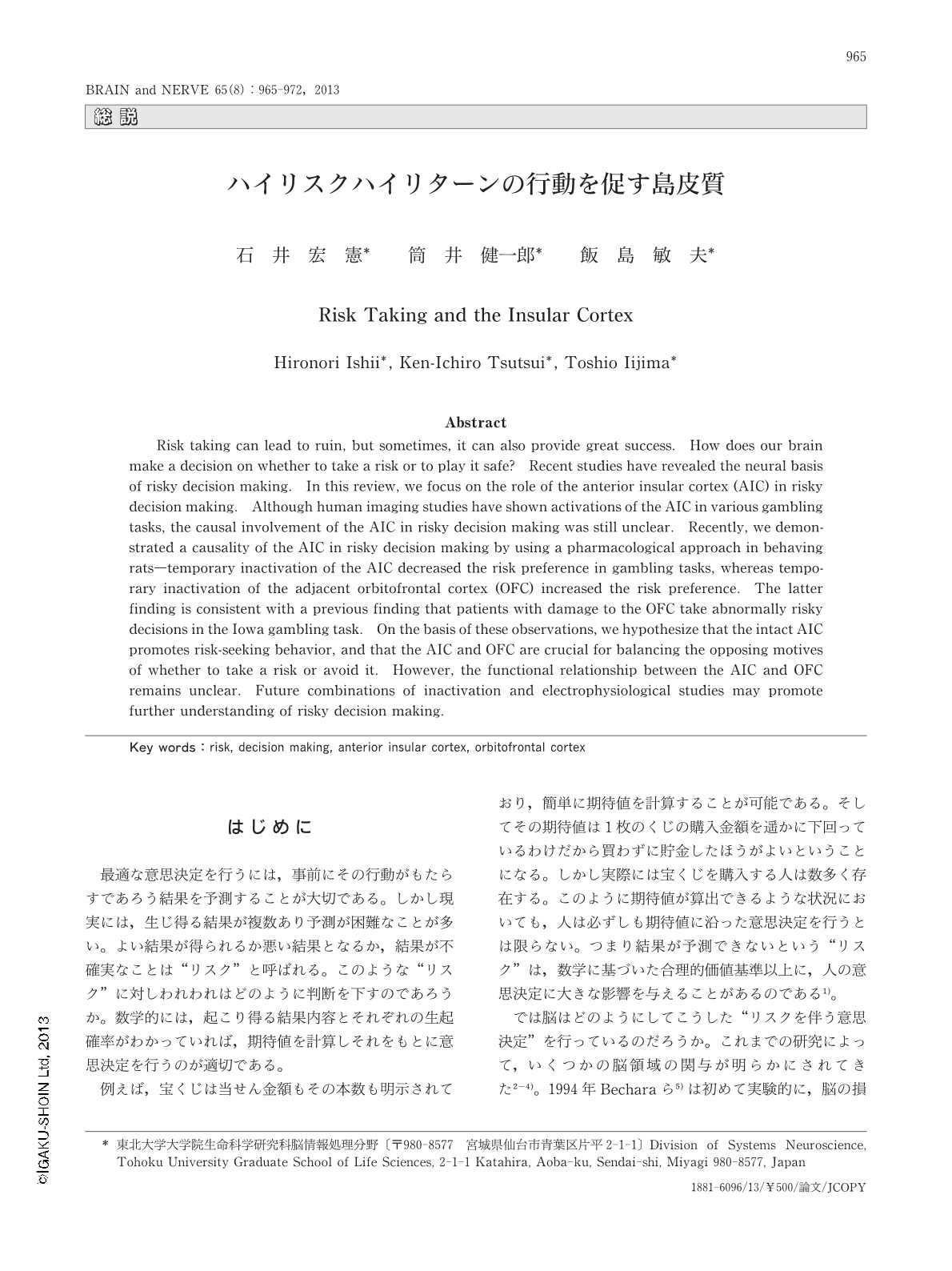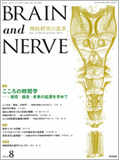Japanese
English
- 有料閲覧
- Abstract 文献概要
- 1ページ目 Look Inside
- 参考文献 Reference
はじめに
最適な意思決定を行うには,事前にその行動がもたらすであろう結果を予測することが大切である。しかし現実には,生じ得る結果が複数あり予測が困難なことが多い。よい結果が得られるか悪い結果となるか,結果が不確実なことは“リスク”と呼ばれる。このような“リスク”に対しわれわれはどのように判断を下すのであろうか。数学的には,起こり得る結果内容とそれぞれの生起確率がわかっていれば,期待値を計算しそれをもとに意思決定を行うのが適切である。
例えば,宝くじは当せん金額もその本数も明示されており,簡単に期待値を計算することが可能である。そしてその期待値は1枚のくじの購入金額を遥かに下回っているわけだから買わずに貯金したほうがよいということになる。しかし実際には宝くじを購入する人は数多く存在する。このように期待値が算出できるような状況においても,人は必ずしも期待値に沿った意思決定を行うとは限らない。つまり結果が予測できないという“リスク”は,数学に基づいた合理的価値基準以上に,人の意思決定に大きな影響を与えることがあるのである1)。
では脳はどのようにしてこうした“リスクを伴う意思決定”を行っているのだろうか。これまでの研究によって,いくつかの脳領域の関与が明らかにされてきた2-4)。1994年Becharaら5)は初めて実験的に,脳の損傷部位と異常なリスク選好性(大きな利益を目指しリスクを積極的に冒す性質)との関係性について言及した。彼らは,アイオワギャンブル課題において前頭眼窩野(を含む前頭前野腹内側部)を損傷した患者が,健常者が避けるようなハイリスクハイリターンな選択を行う傾向を示したことから,前頭眼窩野がリスクを伴う意思決定において重要な役割を果たしていると考えた5,6)。
リスクを伴う意思決定における前頭眼窩野の重要性は,その後の健常者を対象にした脳機能イメージングの研究7-12)によっても支持されたが,それと同時に前頭前野背外側部や腹内側部,帯状回,側坐核,扁桃体などそのほかのさまざまな脳領域の関与についても多くの示唆がなされた13-19)。島皮質はそうした脳機能イメージングの研究によりリスクを伴う意思決定への関与が示唆された領域であり,近年その機能が着目されている20-24)。
筆者らは最近,島皮質前部の不活性化によりリスク選好性が減少することを発見した25)。これは島皮質前部にハイリスクハイリターンの行動を促すような機能がある可能性を示唆している。本稿ではリスクを伴う意思決定における島皮質の機能について,筆者らの研究を中心に,これまでに得られている知見を概説する。
Abstract
Risk taking can lead to ruin, but sometimes, it can also provide great success. How does our brain make a decision on whether to take a risk or to play it safe? Recent studies have revealed the neural basis of risky decision making. In this review, we focus on the role of the anterior insular cortex (AIC) in risky decision making. Although human imaging studies have shown activations of the AIC in various gambling tasks, the causal involvement of the AIC in risky decision making was still unclear. Recently, we demonstrated a causality of the AIC in risky decision making by using a pharmacological approach in behaving rats―temporary inactivation of the AIC decreased the risk preference in gambling tasks, whereas temporary inactivation of the adjacent orbitofrontal cortex (OFC) increased the risk preference. The latter finding is consistent with a previous finding that patients with damage to the OFC take abnormally risky decisions in the Iowa gambling task. On the basis of these observations, we hypothesize that the intact AIC promotes risk-seeking behavior, and that the AIC and OFC are crucial for balancing the opposing motives of whether to take a risk or avoid it. However, the functional relationship between the AIC and OFC remains unclear. Future combinations of inactivation and electrophysiological studies may promote further understanding of risky decision making.

Copyright © 2013, Igaku-Shoin Ltd. All rights reserved.


